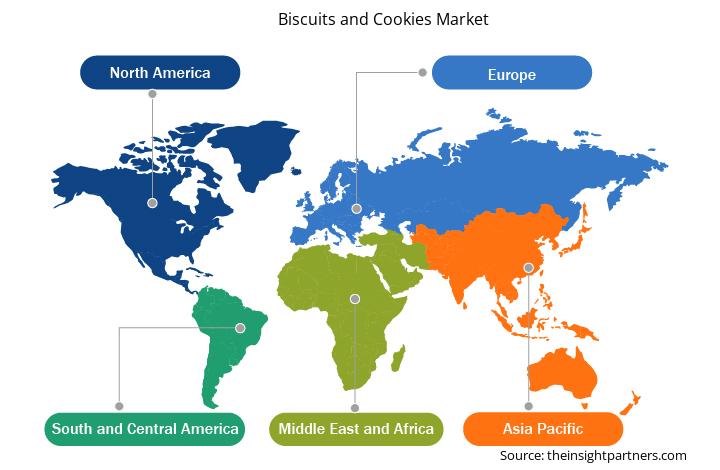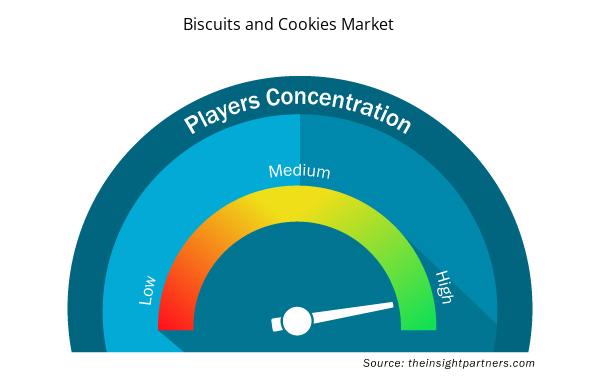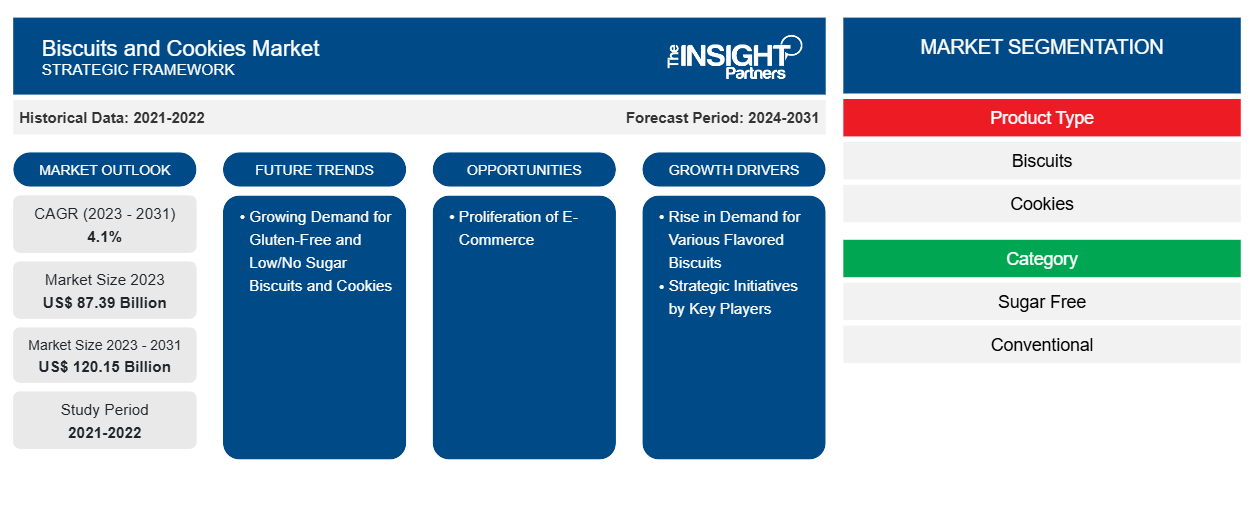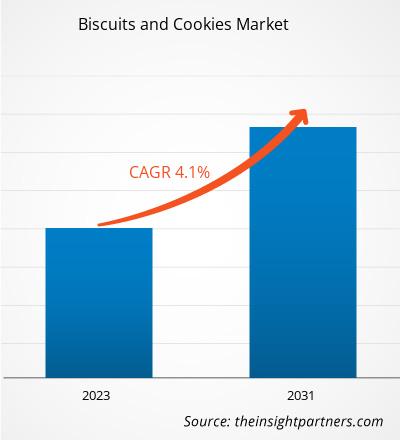饼干和曲奇饼市场规模预计将从 2023 年的 873.9 亿美元增至 2031 年的 1201.5 亿美元。预计 2023-2031 年期间,该市场的复合年增长率将达到 4.1%。预测期内,对无麸质和低糖/无糖饼干和曲奇饼的需求不断增长,可能会为市场带来新的趋势。
饼干和曲奇饼市场分析
消费者对高端食品的兴趣日益增加,以及对舒适食品的沉迷趋势日益增长,是推动饼干和曲奇饼市场增长的主要因素。可支配收入的增加以及对奢华和高端食品的需求不断增加,推动了饼干和曲奇饼市场的增长。电子商务平台的扩张和国际品牌影响力的不断增强进一步刺激了对饼干和曲奇饼的需求。此外,随着越来越多的人移居城市地区并过上更忙碌的生活方式,对即食和方便食品的需求也在不断增长。
饼干和曲奇饼市场概况
饼干和曲奇是小型的加热食品,由面粉、糖、油和其他成分(例如巧克力、燕麦、葡萄干、杏仁、腰果和开心果)以及坚果和种子等其他成分制成。饼干和曲奇主要通过面包店和在线零售渠道销售;它们也可以通过大卖场、杂货店和超市销售。饼干和曲奇是一种受欢迎的早餐,因为它们营养价值高,包括脂肪、纤维和碳水化合物。全球饼干和曲奇市场的增长是由对方便零食的需求不断增长和健康饼干选择的可用性推动的。
定制此报告以满足您的需求
您可以免费定制任何报告,包括本报告的部分内容、国家级分析、Excel 数据包,以及为初创企业和大学提供优惠和折扣
- 获取此报告的关键市场趋势。这个免费样品将包括数据分析,从市场趋势到估计和预测。
饼干和曲奇饼市场的驱动因素和机遇
主要参与者的战略举措
各行业参与者都采取了战略举措,以加强其地位并利用新兴机会。并购是主要参与者为巩固市场份额和扩大产品组合而采取的突出战略举措。例如,2024 年 8 月,Cerealto UK 收购了 Hill Biscuits,标志着其长期私募股权投资者 LDC 退出。此外,合作伙伴关系和协作是饼干和曲奇制造商利用互补优势和资源的其他策略。通过与零售商、分销商或其他食品行业参与者合作,饼干和曲奇生产商可以增强其分销网络,提高品牌知名度并获得新的销售渠道。例如,2024 年 6 月,Mondelēz International 和 Lotus Bakeries 合作在印度生产和销售饼干。根据一项双管齐下的计划,美国糖果和零食巨头 Mondelez 将从其现有的生产网络在印度生产、营销和分销 Biscoff 饼干。主要参与者正在大力投资营销和品牌建设,以建立更强的客户忠诚度。数字营销活动、网红合作和定向广告越来越多地被用于吸引年轻消费者并推广新产品的发布。例如,2023 年 11 月,福克斯的 Burton 投资了数百万美元的马里兰饼干营销活动。该公司推出了一项 360 度营销活动,包括社交和店内活动以及新的电视广告,同时推出了新包装。
电子商务的普及
电子商务的普及预计将为全球饼干和曲奇饼市场的增长带来重大机遇。随着网上购物越来越受欢迎和便利,电子商务平台为饼干和曲奇饼生产商提供了接触全球消费者的直接渠道。通过利用电子商务平台,饼干和曲奇饼制造商可以克服传统的进入壁垒,例如地理限制和分销挑战,并开拓其本地区域以外的新市场。随着消费者越来越多地转向网上购物以寻求便利,饼干和曲奇饼市场有望从更高的知名度和更广泛的产品供应中受益。根据加拿大农业部的数据,在美国,从 2019 年到 2023 年,食品杂货电子商务销售额每年增长 26.4%。电子商务平台为饼干和曲奇饼生产商提供了展示其产品和直接与消费者沟通的灵活性,从而提高了品牌知名度和客户参与度。此外,电子商务使饼干和曲奇饼生产商能够通过数据分析收集有关消费者偏好和市场趋势的宝贵见解,从而使他们能够相应地定制其产品和营销策略。
饼干和曲奇饼市场报告细分分析
有助于饼干和曲奇饼市场分析的关键部分是产品类型、类别和分销渠道。
- 根据产品类型,市场分为饼干和曲奇饼。饼干部分细分为甜味普通饼干、咸味饼干、涂层饼干、夹心饼干、威化饼干和其他饼干。曲奇饼部分进一步细分为巧克力曲奇饼、酥饼、黄油饼干、夹心饼干和其他饼干。饼干部分在 2023 年占据了更大的市场份额。
- 从类别来看,市场分为无糖和传统两类。2023 年,传统类别占据了市场主导地位。
- 根据分销渠道,市场分为超市和大卖场、便利店、在线零售和其他。2023 年,在线零售占据了市场主导地位。
饼干和曲奇饼市场份额按地区分析
饼干和曲奇饼市场的地理范围主要分为五个地区:北美、亚太、欧洲、中东和非洲、南美和中美。
饼干和曲奇在亚太地区越来越受欢迎。市场提供各种各样的饼干和曲奇,包括经典的纯味、巧克力味、无麸质味以及注入各种水果和口味的品种。这些多样化的选择旨在满足消费者的口味和喜好。由于消费者对零食选择的兴趣日益浓厚,对方便、即食食品的需求不断增加,亚太地区的饼干和曲奇市场正在迅速扩张。可支配收入的增加、快速的城市化和生活水平的提高推动了饼干和曲奇市场的增长。消费者正在寻求更健康、更有营养的食品,从而导致对低糖、无麸质和高纤维饼干和曲奇的需求增加。此外,优质产品的日益普及、对手工饼干和曲奇的需求不断增长以及饼干和曲奇中多种口味的供应不断增加,预计将为市场创造有利可图的机会。饼干和曲奇饼市场中的多家国内外参与者正在采取战略举措,例如建立合作伙伴关系、开展合作、扩张和推出产品,以满足该地区消费者对饼干和曲奇饼日益增长的需求。例如,2024 年 6 月,Universal Robina Corp 将收购的 Munchy's 饼干和曲奇饼业务整合到其马来西亚子公司后,将其业务扩展到东南亚。
饼干和曲奇饼市场区域洞察
Insight Partners 的分析师已详尽解释了预测期内影响饼干和曲奇饼市场的区域趋势和因素。本节还讨论了北美洲、欧洲、亚太地区、中东和非洲以及南美洲和中美洲的饼干和曲奇饼市场细分和地理位置。

- 获取饼干和曲奇饼市场的区域特定数据
饼干和曲奇饼市场报告范围
| 报告属性 | 细节 |
|---|---|
| 2023 年的市场规模 | 873.9亿美元 |
| 2031 年市场规模 | 1201.5亿美元 |
| 全球复合年增长率(2023 - 2031) | 4.1% |
| 史料 | 2021-2022 |
| 预测期 | 2024-2031 |
| 涵盖的领域 | 按产品类型
|
| 覆盖地区和国家 | 北美
|
| 市场领导者和主要公司简介 |
|
饼干和曲奇饼市场参与者密度:了解其对业务动态的影响
饼干和曲奇饼市场正在快速增长,这得益于终端用户需求的不断增长,而这些需求又源于消费者偏好的不断变化、技术进步以及对产品优势的认识不断提高等因素。随着需求的增加,企业正在扩大其产品范围,进行创新以满足消费者的需求,并利用新兴趋势,从而进一步推动市场增长。
市场参与者密度是指在特定市场或行业内运营的企业或公司的分布情况。它表明在给定市场空间中,相对于其规模或总市场价值,有多少竞争对手(市场参与者)存在。
在饼干和曲奇饼市场运营的主要公司有:
- 通用磨坊公司
- Pladis 食品有限公司
- 亿滋国际
- 费列罗国际公司
- 伯顿饼干公司
- 雀巢公司
免责声明:上面列出的公司没有按照任何特定顺序排列。

- 获取饼干和曲奇饼市场顶级关键参与者概述
饼干和曲奇饼市场新闻和最新发展
饼干和曲奇饼市场通过收集一手和二手研究后的定性和定量数据进行评估,其中包括重要的公司出版物、协会数据和数据库。饼干和曲奇饼市场最近的一个关键发展如下:
- Reliance 与 General Mills 合作进军零食市场,进一步扩大 RCPL 在印度包装消费品市场的产品组合。(来源:General Mills Inc,新闻稿,2023 年 5 月)
Mondelēz International 推出了八款不含 HFSS 的饼干、糖果和巧克力饮料产品,旨在提供各种不含高脂肪、盐或糖 (HFSS) 的零食选择,这些零食来自 belVita、Cadbury Drinking Chocolate、Maynards Bassetts 和 The Natural Confectionery Company 等知名品牌。(来源:Mondelēz International Inc,新闻稿,2022 年 8 月)
饼干和曲奇饼市场报告覆盖范围和交付成果
“饼干和曲奇饼市场规模和预测(2021-2031 年)”报告对市场进行了详细的分析,涵盖以下领域:
- 饼干和曲奇饼的市场份额以及全球、区域和国家层面所有主要细分市场的预测
- 饼干和曲奇饼的市场趋势,以及市场动态,如驱动因素、限制因素和关键机会
- 详细的波特五力分析和 SWOT 分析
- 饼干和曲奇饼市场涵盖主要市场趋势、全球和区域框架、主要参与者、法规和最新市场发展
- 行业格局和竞争分析,涵盖市场集中度、热图分析、知名企业以及饼干和曲奇市场的最新发展
- 详细的公司简介
- 历史分析(2 年)、基准年、预测(7 年)及复合年增长率
- PEST 和 SWOT 分析
- 市场规模价值/数量 - 全球、区域、国家
- 行业和竞争格局
- Excel 数据集


- Health Economics and Outcome Research (HEOR) Services Market
- Online Recruitment Market
- Animal Genetics Market
- Europe Surety Market
- Adaptive Traffic Control System Market
- Surety Market
- Fish Protein Hydrolysate Market
- Integrated Platform Management System Market
- Social Employee Recognition System Market
- Dairy Flavors Market

Report Coverage
Revenue forecast, Company Analysis, Industry landscape, Growth factors, and Trends

Segment Covered
This text is related
to segments covered.

Regional Scope
North America, Europe, Asia Pacific, Middle East & Africa, South & Central America

Country Scope
This text is related
to country scope.
常见问题
Europe accounted for the largest share of the market in 2023.
A rise in demand for various flavored biscuits and strategic initiatives by key players are major factors contributing to the growth of the market.
The growing demand for gluten-free and low/no sugar biscuits and cookies is likely to emerge as a key trend in the market in the future.
General Mills Inc, Pladis Foods Ltd, Mondelez International Inc, Ferrero International SA, Burton's Biscuit Co, Nestle SA, J M Smucker Co, Still Sweet LLC, ITC Ltd, Lotus Bakeries NV, Campbell Soup Co, Parle Products Pvt Ltd, Galletas Gullon SA, UNIBIC Foods India Pvt Ltd, and Britannia Industries Ltd are a few of the key players operating in the biscuits and cookies market.
The market size is projected to reach US$ 120.15 billion by 2031.
Trends and growth analysis reports related to Food and Beverages : READ MORE..
The List of Companies - Biscuits and Cookies Market
- General Mills Inc
- Pladis Foods Ltd
- Mondelez International Inc
- Ferrero International SA
- Burton's Biscuit Co
- Nestle SA
- J M Smucker Co
- Still Sweet LLC
- ITC Ltd
- Lotus Bakeries NV
- Campbell Soup Co
- Parle Products Pvt Ltd
- Galletas Gullon SA
- UNIBIC Foods India Pvt Ltd
- Britannia Industries Ltd
The Insight Partners performs research in 4 major stages: Data Collection & Secondary Research, Primary Research, Data Analysis and Data Triangulation & Final Review.
- Data Collection and Secondary Research:
As a market research and consulting firm operating from a decade, we have published and advised several client across the globe. First step for any study will start with an assessment of currently available data and insights from existing reports. Further, historical and current market information is collected from Investor Presentations, Annual Reports, SEC Filings, etc., and other information related to company’s performance and market positioning are gathered from Paid Databases (Factiva, Hoovers, and Reuters) and various other publications available in public domain.
Several associations trade associates, technical forums, institutes, societies and organization are accessed to gain technical as well as market related insights through their publications such as research papers, blogs and press releases related to the studies are referred to get cues about the market. Further, white papers, journals, magazines, and other news articles published in last 3 years are scrutinized and analyzed to understand the current market trends.
- Primary Research:
The primarily interview analysis comprise of data obtained from industry participants interview and answers to survey questions gathered by in-house primary team.
For primary research, interviews are conducted with industry experts/CEOs/Marketing Managers/VPs/Subject Matter Experts from both demand and supply side to get a 360-degree view of the market. The primary team conducts several interviews based on the complexity of the markets to understand the various market trends and dynamics which makes research more credible and precise.
A typical research interview fulfils the following functions:
- Provides first-hand information on the market size, market trends, growth trends, competitive landscape, and outlook
- Validates and strengthens in-house secondary research findings
- Develops the analysis team’s expertise and market understanding
Primary research involves email interactions and telephone interviews for each market, category, segment, and sub-segment across geographies. The participants who typically take part in such a process include, but are not limited to:
- Industry participants: VPs, business development managers, market intelligence managers and national sales managers
- Outside experts: Valuation experts, research analysts and key opinion leaders specializing in the electronics and semiconductor industry.
Below is the breakup of our primary respondents by company, designation, and region:

Once we receive the confirmation from primary research sources or primary respondents, we finalize the base year market estimation and forecast the data as per the macroeconomic and microeconomic factors assessed during data collection.
- Data Analysis:
Once data is validated through both secondary as well as primary respondents, we finalize the market estimations by hypothesis formulation and factor analysis at regional and country level.
- Macro-Economic Factor Analysis:
We analyse macroeconomic indicators such the gross domestic product (GDP), increase in the demand for goods and services across industries, technological advancement, regional economic growth, governmental policies, the influence of COVID-19, PEST analysis, and other aspects. This analysis aids in setting benchmarks for various nations/regions and approximating market splits. Additionally, the general trend of the aforementioned components aid in determining the market's development possibilities.
- Country Level Data:
Various factors that are especially aligned to the country are taken into account to determine the market size for a certain area and country, including the presence of vendors, such as headquarters and offices, the country's GDP, demand patterns, and industry growth. To comprehend the market dynamics for the nation, a number of growth variables, inhibitors, application areas, and current market trends are researched. The aforementioned elements aid in determining the country's overall market's growth potential.
- Company Profile:
The “Table of Contents” is formulated by listing and analyzing more than 25 - 30 companies operating in the market ecosystem across geographies. However, we profile only 10 companies as a standard practice in our syndicate reports. These 10 companies comprise leading, emerging, and regional players. Nonetheless, our analysis is not restricted to the 10 listed companies, we also analyze other companies present in the market to develop a holistic view and understand the prevailing trends. The “Company Profiles” section in the report covers key facts, business description, products & services, financial information, SWOT analysis, and key developments. The financial information presented is extracted from the annual reports and official documents of the publicly listed companies. Upon collecting the information for the sections of respective companies, we verify them via various primary sources and then compile the data in respective company profiles. The company level information helps us in deriving the base number as well as in forecasting the market size.
- Developing Base Number:
Aggregation of sales statistics (2020-2022) and macro-economic factor, and other secondary and primary research insights are utilized to arrive at base number and related market shares for 2022. The data gaps are identified in this step and relevant market data is analyzed, collected from paid primary interviews or databases. On finalizing the base year market size, forecasts are developed on the basis of macro-economic, industry and market growth factors and company level analysis.
- Data Triangulation and Final Review:
The market findings and base year market size calculations are validated from supply as well as demand side. Demand side validations are based on macro-economic factor analysis and benchmarks for respective regions and countries. In case of supply side validations, revenues of major companies are estimated (in case not available) based on industry benchmark, approximate number of employees, product portfolio, and primary interviews revenues are gathered. Further revenue from target product/service segment is assessed to avoid overshooting of market statistics. In case of heavy deviations between supply and demand side values, all thes steps are repeated to achieve synchronization.
We follow an iterative model, wherein we share our research findings with Subject Matter Experts (SME’s) and Key Opinion Leaders (KOLs) until consensus view of the market is not formulated – this model negates any drastic deviation in the opinions of experts. Only validated and universally acceptable research findings are quoted in our reports.
We have important check points that we use to validate our research findings – which we call – data triangulation, where we validate the information, we generate from secondary sources with primary interviews and then we re-validate with our internal data bases and Subject matter experts. This comprehensive model enables us to deliver high quality, reliable data in shortest possible time.


 获取此报告的免费样本
获取此报告的免费样本